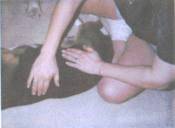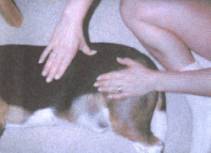Backing up your dog with Massage
By Maria K. Duthie c.e.f.m.p
Each muscle in your dogs body works together to form a picture of speed and grace. If one of those muscles is tight it can throw off the entire picture making it difficult for the dog to perform up to his or her ability. One group of muscles that can effect many of the dogs’ movements is the back muscles. In the following article we will discuss some things the back does and how we can help keep it in shape.
The two main muscles in the back are the Latissimus Dorsi and the Longissimus Dorsi.  These two work together to move the dog. The muscle towards the dogs’ neck and shoulders is the latissimus, which pulls the body forward. For example, when running the Latissimus assists the shoulders in pulling the dog forward. The hind portion of the back is primarily made up of the Longissimus Dorsi. This muscle works to curve the spine, which is important in several movements including jumping. If one of these muscles is strained or in spasm it can be difficult to achieve optimum movement. Sometimes back problems can be thought to be something else as well. These two work together to move the dog. The muscle towards the dogs’ neck and shoulders is the latissimus, which pulls the body forward. For example, when running the Latissimus assists the shoulders in pulling the dog forward. The hind portion of the back is primarily made up of the Longissimus Dorsi. This muscle works to curve the spine, which is important in several movements including jumping. If one of these muscles is strained or in spasm it can be difficult to achieve optimum movement. Sometimes back problems can be thought to be something else as well.
Some things to watch for are stiff movement in the joints of the hind legs, or a raised spine. This can be indicative of pain and stiffness in the lumbar area, which would be the Longissimus Dorsi. If there are problems with the Latissimus Dorsi there could be stiffness in the shoulders and notable spasms behind the shoulder blade itself. It is important to remember that any significant problems need to be addressed by a veterinarian.
The following techniques can be done to maintain a healthy supple back. If at any time you do not feel comfortable with what you are doing or the dogs is not comfortable stop and get further instruction from a professional. One of the best things for a back, especially the lumbar area is a heating pad. You can place this on the dog from just behind the hips to the ribs if they allow it. Put it on low heat for ten to fifteen minutes.
 This will increase the circulation to the area and help to soften the muscle tissue. If the dog does not like the heating pad try passive touch in the same area. All you do is place both hands on the lumbar region or any other part of the back that is tight. Make sure you do not apply any pressure with this technique. It is as if you are setting your hand on your leg. Allow the entire surface of both hands to touch the dogs’ body. The heat from your hands will do the same thing as the heating pad. Hold your hands there as long as you both can handle it. This will increase the circulation to the area and help to soften the muscle tissue. If the dog does not like the heating pad try passive touch in the same area. All you do is place both hands on the lumbar region or any other part of the back that is tight. Make sure you do not apply any pressure with this technique. It is as if you are setting your hand on your leg. Allow the entire surface of both hands to touch the dogs’ body. The heat from your hands will do the same thing as the heating pad. Hold your hands there as long as you both can handle it.
 Thumb gliding is a massage technique that can be done next to the spine to smooth the tissue out. Take the flat of your thumb and begin at the point of the shoulder blade. Approximately a quarter of an inch from the spine lightly glide the flat of your thumb down to the point of the hip. If you like you can circle the hip which will help strengthen the hip area. Begin with light pressure and slowly increase according to your dogs’ response. If they appear uncomfortable decrease the pressure and make sure you are using the flat of your thumb. It is always good to practice on yourself first. You might feel a spasm when doing this. A spasm will feel like an intense shake or quiver. If you do feel a spasm just stop and hold the area with your thumb. Do not change the pressure just keep it constant until the spasm releases or stops shaking. The most important thing is top work with your dog. Never push or force your dog to have a massage. When massaging your dog always keep two hands on them to make a connection. These hands are not there to hold the dog down but rather to relax them. Also make sure you are in a relaxed frame of mind so the massage can be gentle and soothing for both of you. With animal massage trust is the most important thing. They are giving you their bodies so it is important to treat them with respect so that you do not break that trust. Thumb gliding is a massage technique that can be done next to the spine to smooth the tissue out. Take the flat of your thumb and begin at the point of the shoulder blade. Approximately a quarter of an inch from the spine lightly glide the flat of your thumb down to the point of the hip. If you like you can circle the hip which will help strengthen the hip area. Begin with light pressure and slowly increase according to your dogs’ response. If they appear uncomfortable decrease the pressure and make sure you are using the flat of your thumb. It is always good to practice on yourself first. You might feel a spasm when doing this. A spasm will feel like an intense shake or quiver. If you do feel a spasm just stop and hold the area with your thumb. Do not change the pressure just keep it constant until the spasm releases or stops shaking. The most important thing is top work with your dog. Never push or force your dog to have a massage. When massaging your dog always keep two hands on them to make a connection. These hands are not there to hold the dog down but rather to relax them. Also make sure you are in a relaxed frame of mind so the massage can be gentle and soothing for both of you. With animal massage trust is the most important thing. They are giving you their bodies so it is important to treat them with respect so that you do not break that trust.
The back is just one of many areas that can impact the way your dog goes. In future articles we will continue to discuss how we can help promote healthy muscle in the entire body. For further information on massage or help with what we have already covered please email m.duthie@verizon.net or visit annisage.com.

|

These two work together to move the dog. The muscle towards the dogs’ neck and shoulders is the latissimus, which pulls the body forward. For example, when running the Latissimus assists the shoulders in pulling the dog forward. The hind portion of the back is primarily made up of the Longissimus Dorsi. This muscle works to curve the spine, which is important in several movements including jumping. If one of these muscles is strained or in spasm it can be difficult to achieve optimum movement. Sometimes back problems can be thought to be something else as well.
This will increase the circulation to the area and help to soften the muscle tissue. If the dog does not like the heating pad try passive touch in the same area. All you do is place both hands on the lumbar region or any other part of the back that is tight. Make sure you do not apply any pressure with this technique. It is as if you are setting your hand on your leg. Allow the entire surface of both hands to touch the dogs’ body. The heat from your hands will do the same thing as the heating pad. Hold your hands there as long as you both can handle it.
Thumb gliding is a massage technique that can be done next to the spine to smooth the tissue out. Take the flat of your thumb and begin at the point of the shoulder blade. Approximately a quarter of an inch from the spine lightly glide the flat of your thumb down to the point of the hip. If you like you can circle the hip which will help strengthen the hip area. Begin with light pressure and slowly increase according to your dogs’ response. If they appear uncomfortable decrease the pressure and make sure you are using the flat of your thumb. It is always good to practice on yourself first. You might feel a spasm when doing this. A spasm will feel like an intense shake or quiver. If you do feel a spasm just stop and hold the area with your thumb. Do not change the pressure just keep it constant until the spasm releases or stops shaking. The most important thing is top work with your dog. Never push or force your dog to have a massage. When massaging your dog always keep two hands on them to make a connection. These hands are not there to hold the dog down but rather to relax them. Also make sure you are in a relaxed frame of mind so the massage can be gentle and soothing for both of you. With animal massage trust is the most important thing. They are giving you their bodies so it is important to treat them with respect so that you do not break that trust.
